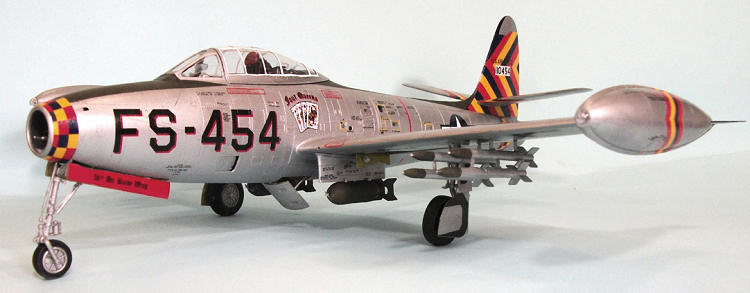
Hobby Boss 1/32 F-84G Thunderjet
| KIT #: | 83208 |
| PRICE: |
7,840 yen at
HobbyLink |
| DECALS: | Two options |
| REVIEWER: | Tom Cleaver |
| NOTES: |

| HISTORY |
Republic began design of the AP-23 jet fighter in 1944, to meet a General
Operational Requirement for a single-seat day fighter with a speed of 600 mph, a
combat radius of 850 miles, an armament of six .50 caliber machine guns.
Power was to be provided by the General Electric TG-180 axial flow jet
turbine.
The airplane would become
known as the F-84 Thunderjet, one of the most successful early jets.
Alexander Karveli’s design utilized a straight-through airflow with a
simple pitot intake, seeking to combine maximum flow efficiency with the highest
possible Mach number.
The
exceptional fineness ratio of the airframe resulted in exceptionally low drag.
The unswept wing had an aspect ratio of 5.1:1, chosen as a compromise
between the high value needed for range and the low value demanded to delay
compressibility drag rise.
100
P-84s were ordered off the drawing board on
The first XP-84 took flight at Muroc Army Air Base on
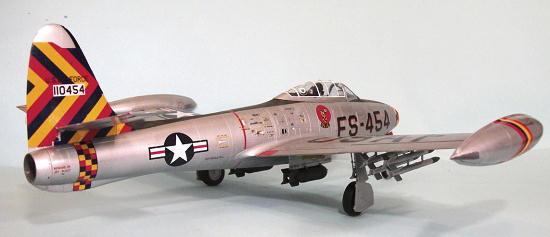 Flight development proceeded
slowly due to delayed engine deliveries as Allison struggled to turn the TG-180
into the production J-35.
With the
problems that began to emerge in late 1946, contracts for additional aircraft
were not signed until June 1947, which was only for 191 aircraft rather than the
411 expected.
Flight development proceeded
slowly due to delayed engine deliveries as Allison struggled to turn the TG-180
into the production J-35.
With the
problems that began to emerge in late 1946, contracts for additional aircraft
were not signed until June 1947, which was only for 191 aircraft rather than the
411 expected.
The first production aircraft was the F-84B, which was virtually
identical to the YP-84As other than carrying an ejection seat.
The first unit to receive the Thunderjet was the 14th Fighter
Group, beginning in mid-1947 with Initial Operational Capability achieved in
December 1947.
Production of 226
F-84Bs was completed in June 1948.
In service, the F-84B was restricted to a top speed of Mach 0.8 because of trim
reversal at higher speeds.
In May
1948 all F-84Bs were grounded due to structural failure.
In May 1949 a program of over 100 structural and engineering
modifications including wing strengthening was adopted.
The 191 F-84C Thunderjets introduced an uprated J-35 and a new electrical
system; these aircraft suffered the same problems as the B-model and were given
the same extensive modification program.
The F-84B and F-94C were withdrawn from service in 1952
The first really combat-capable Thunderjet was the F-84D, 154 of which
were produced, beginning in November 1948 and ending in April 1949.
Continued maintenance difficulties, poor serviceability and performance
shortfall led to the conclusion that the F-84B and C could not fulfill any
mission and cancellation of the F-84D was considered.
A special test of the F-84D at Wright Patterson and Eglin AFBs in
February and march 1949 showed that this version was finally able to perform
both the fighter and fighter-bomber mission adequately
The much-improved F-84E was first discussed in 1948.
Using the 5,000 lb thrust J-35A-17 engine, which provided a 20 percent
power increase, Republic lengthened the fuselage to provide more fuel and a more
comfortable cockpit and the A-1B radar gunsight was installed.
The wing-tip tanks were approved for use during combat and prpovision was
made for additional 230-gallon drop tanks to be carried on the inner wing bomb
shackles, extending the combat radius to over 1,000 miles.
The first 1949 contract was for 409 aircraft, followed on by four other
contracts that brought the production total to 843 aircraft.
Having demonstrated inferiority to the MiG-15 when introduced to Korean
combat in December 1950 by the 27th Fighter Escort Wing, the F-84
became the main Air Force fighter-bomber used during the Korean War.
The F-84E participated in the development of in-flight refueling
techniques, which led to the development of the F-84G Thunderjet, which could
use the Boeing “flying boom” refueling system.
With an increase in power available to 5,600 lbs thrust and the new A-4
radar gunsight, the F-84G was also the first single-seat, single engine aircraft
cleared to carry a tactical nuclear
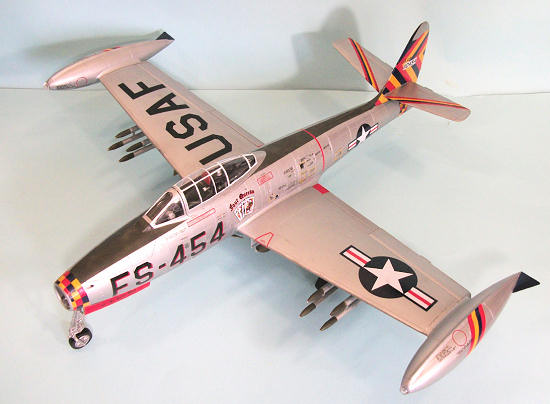 bomb.
3,045 F-84Gs were produced, of which 789 went to the USAF and the rest to
NATO air forces, with delivery beginning in July 1951.
The F-84G arrived in
bomb.
3,045 F-84Gs were produced, of which 789 went to the USAF and the rest to
NATO air forces, with delivery beginning in July 1951.
The F-84G arrived in
The Thunderjet in
September 19, 1951: the F-84E "Thunderjets" of the 9th Fighter
Squadron of the veteran 49th Fighter Wing headed north at 12,000
feet, each loaded with two 500-pound bombs, along with the 7th and 8th
squadrons, the 49ers were tasked to dive bomb the main rail line between Sinanju
and Pyongyang at a "choke point" just south of Sukchon where the line went
through a marshy area between two hills - the most difficult place for the enemy
to have to make repairs.
It was
their second mission of the day.
Leading the Purple Flight was 9th Squadron C.O.
As the Thunderjets crossed the bomb line, the weather changed from the
clear skies in the south to broken clouds that became a heavy undercast by the
time the 48 F-84s passed east of Pyongyang.
"I heard the Group Commander call out MiGs above us at seven o-clock, and
saw the contrails.
I told the rest
of the squadron not to pickle their bombs if they made a pass on us unless it
was life and death.
At our
altitude, the MiG was not that good, and I was pretty sure we could turn away
from them with our ordnance.
I knew
they wouldn't stick around that low with 48 of us wanting to take a crack at
them."
While the MiG-15 had
demonstrated superiority to the Thunderjet in air-to-air combat, in the hands of
an experienced pilot the F-84 could hold its own at lower altitudes against the
lesser-trained Communist pilots; the 49th Fighter Group was a collection highly
experienced flyers, with most pilots having flown at least 50 combat missions.
"I watched the MiGs above us, and saw them head down.
They were coming right after the four of us in the lead, so I very
reluctantly called for Purple Flight to salvo their bombs.
I broke hard to the right as I saw them set up on their firing pass and
they overshot.
I reversed the turn
to the left, and saw Ken Skeen pulling up high to my left and falling behind as
I came around into the MiGs before they could get away to set up another pass.
I got off some shots at two of them, and then warned Jim Sprinkle that he
had one on his tail.
Suddenly the
MiG on Jim's tail caught fire and was trailing smoke.
Then Ken Skeen called to break right, because I had another one on me.
Ken had shot the one on Sprinkle's tail, and he kept at it till it blew
up."
Though the mission was unsuccessful, inasmuch as the MiGs had managed to
catch the 49th without their Sabre escort and forced them to jettison all bombs
in the melee that resulted, there was an appropriate celebration back at Taegu
that night, since Skeen had scored the group's first MiG kill with the F-84.
"The next day, I had each airplane in the 9th painted with a red star to
celebrate that kill.
It became part
of the squadron insignia for the rest of the war," Williams recalled.
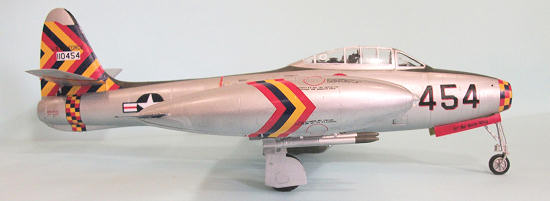 By this stage of the war, sobering knowledge of the enemy was dictating
Air Force strategy.
The two wings
of long-range F-84 Thunderjet bombers that were rapidly becoming the most
important tactical aircraft of the war besides the F-86 Sabre whose battle for
air superiority in Mig Alley over the Yalu made the extended operations over the
north by the F-84s possible.
The
Chinese had approximately 60 divisions in Korea; each required 40 tons of
supplies per day for effective operation.
The air interdiction campaign had reduced rail traffic to a minimum in
North Korea, which meant that 6,000 trucks per day had to deliver their supplies
to the front lines for the Communists to maintain their position against the
United Nations forces.
"Operation
Strangle" began officially in July 1951, with the goal of cutting off the
Communist front lines from their supplies to the maximum extent feasible.
Only American air superiority made this possible.
By this stage of the war, sobering knowledge of the enemy was dictating
Air Force strategy.
The two wings
of long-range F-84 Thunderjet bombers that were rapidly becoming the most
important tactical aircraft of the war besides the F-86 Sabre whose battle for
air superiority in Mig Alley over the Yalu made the extended operations over the
north by the F-84s possible.
The
Chinese had approximately 60 divisions in Korea; each required 40 tons of
supplies per day for effective operation.
The air interdiction campaign had reduced rail traffic to a minimum in
North Korea, which meant that 6,000 trucks per day had to deliver their supplies
to the front lines for the Communists to maintain their position against the
United Nations forces.
"Operation
Strangle" began officially in July 1951, with the goal of cutting off the
Communist front lines from their supplies to the maximum extent feasible.
Only American air superiority made this possible.
The effect of this operation was to force the Communist air forces to
attempt to block the fighter bombers.
As F-84s inbound for a strike passed between Sonchon in the south and
Sinanju, the Communists would get word of the size of the strike.
The MiGs would take off from the airfield complex at Antung in
"off-limits" Manchuria then climb to their ceiling of 50,000 feet and overfly
the F-86 patrols south of the Yalu, to hit the fighter bombers north of Sinanju
with the objective of making them jettison their bombs and defend themselves
against the superior MiGs. While only a few F-84s were shot down by the MiG-15s,
the Communists gained their goal with the first pass as the Thunderjets salvoed
their bombs.
Combined with the
great increase in AAA weapons south of Sonchon along the Main Line of
Resistance, it was estimated by December 1951 that only seven percent of the
bombs dropped hit the intended targets.
By October, with 70 operational F-84s, the 49th Fighter Wing
flew 1,727 sorties, mostly deep-penetration raids, which were so effective that
by mid-November any strike north of Pyongyang could expect to be intercepted by
MiGs.
"We kept our losses down with
our tactics," explained Williams.
"We maintained close formations, and we always turned into them once they
committed to their gunnery run.
Our
ability to out-turn them at our operational altitude was crucial to survival."
Williams was detached from the 9th Squadron in early 1952 to
participate in what became known as Operation High Tide, the use of F-84s for
long-range attacks supported by in-flight refueling.
Williams returned to the squadron in the summer of 1952.
By this point, he had flown the equivalent of three complete tours, but
had no plans to leave.
"I knew Don
Blakeslee, and I knew how he had doctored his books in England during World War
II, listing any mission that didn't contact the enemy as a training flight, any
mission flown with another unit as orientation, things like that.
I did the same thing myself.
I know it may not sound particularly right these days, but the flying we were
doing in Korea was very satisfying to me and I didn't want to stop.”
Aircraft attrition had been so bad that in April 1952 the 49th only had
41 operational aircraft.
Delivery
of the "definitive" F-84G had been delayed, and operations in Korea were
hamstrung by lack of aircraft.
The
situation got so bad the only way the Air Force could make up the attrition was
to send 102 F-84Ds to the far east, which was not seen as progress.
In order to lower maintenance problems, the 136th Wing handed over all
its F-84Es to the 49th Wing, and began operating the D-models. The crisis eased
in the summer of 1952, as the 49th Wing had took delivery of their first F-84Gs
in July and were fully-equipped with the "definitive" Thunderjet by October
1952.
Williams was involved in the final development of Thunderjet tactics in
the Korean War - the use of the airplane as a night intruder over the north.
"The Douglas B-26 was the workhorse over the north at night, but the
Communists were getting used to them, to the speed with which they could make an
attack, and the gun crews were starting to hit them more often.
We figured that with the Thunderjet, we could hit them fast enough the
gun crews would be firing at our engine sound, which would be behind us."
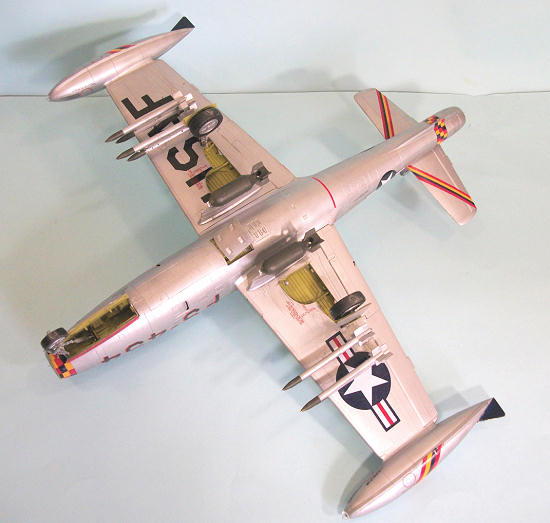 The F-84 was not designed for night operations, and the instrument panel
lighting was modified.
"Even then,
it was bright enough that to check the panel you needed to close one eye and put
your hand over it before you looked down, so you'd still have night vision."
The Thunderjet carried two 1,000-pound bombs for these missions, set with
proximity fuses so they would explode 50 to 100 feet above ground.
"Our plan was to harass the crews who were working on the trucks,
repairing the roads, things like that."
The F-84 was not designed for night operations, and the instrument panel
lighting was modified.
"Even then,
it was bright enough that to check the panel you needed to close one eye and put
your hand over it before you looked down, so you'd still have night vision."
The Thunderjet carried two 1,000-pound bombs for these missions, set with
proximity fuses so they would explode 50 to 100 feet above ground.
"Our plan was to harass the crews who were working on the trucks,
repairing the roads, things like that."
Flying over North Korea at night was far different. "In the daytime, you
could fly over the whole country and never see anything moving, but at night
you'd be at 30,000 feet and you could see every major supply route up there
completely lit up with truck headlights!"
The mere presence of the F-84s had its own effect on the enemy.
"When we got over station and they could hear us on the ground, all those
lights would go out, and you knew they were reduced to about walking speed, if
they could move at all, and they sure weren't getting any repairs made with no
light. Our biggest problem would be if a searchlight got lucky and lit up the
cockpit - if that happened it would be pretty easy to fly into a mountainside
and never see a thing."
At night, the pilots could also spot trains.
"I came up with the tactic of getting down low, where you could see the
reflected moonlight on the tracks," Williams explained.
"When you lost the reflection, you knew there was a train there and you
could swing in on an attack before they could run it into a tunnel to hide it.
One of our guys found an ammo train as I was coming up to relieve him on
station, and he got lucky with both his bombs.
I was 100 miles away when that thing went up and it was the biggest
fireworks display I ever saw!"
Despite its faults, Williams appreciated the Thunderjet. "It was a maintenance hog, and the TBO on the engine was horrible until we got to the G-model. Everything you've ever heard about the airplane taking every inch of runway to get airborne is true. But as far as jets were concerned, it was about as rugged as the old Thunderbolt. We got chewed up by flak and by MiGs, and brought them home with some pretty big holes in them. The ground crews managed to put them back together and they kept on flying. I never knew a pilot who didn't think the Thunderjet would get him home as long as the wing hadn't been shot off." By the end of the war in July 1953, Willie Williams would be the high-time Air Force pilot of the Korean War in terms of missions flown and hours logged, flying from November 1950 to the end.
| THE KIT |
This is Hobby Boss’ second 1/32 F-84 kit, the first being the F-84E
released last spring.
The main
difference between this F-84G kit and that kit is the lower fuselage panel that
has the blow-in doors.
Decals are
provided for two aircraft, the famous “Four Queens” flown by the Wing Commander
of the 58th Fighter Bomber Wing in late 1952, and an F-84G used by
the French Air Force.
| CONSTRUCTION |
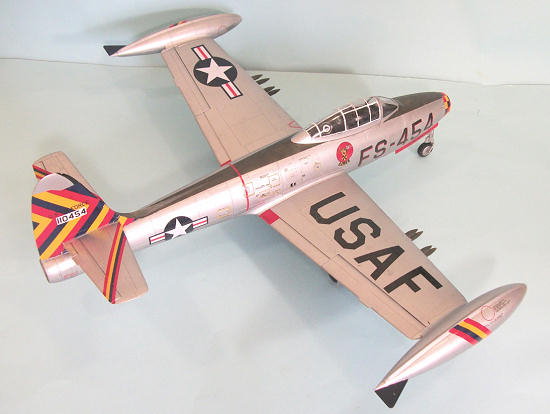
| COLORS & MARKINGS |
I gave the model an overall primer coat of Tamiya Flat Aluminum, then
gave a thin coat of Talon “aluminum,” which I then masked and did different
panel colors using the Auto Air “Aluminum” and “Pearlized Silver” colors. These
work much better
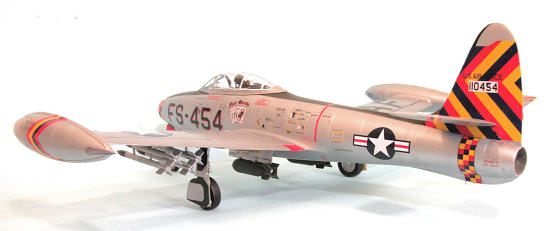 going on over a painted surface than bare plastic.
The anti-glare panel was done with Gunze-Sangyo “Olive Drab 1.”
going on over a painted surface than bare plastic.
The anti-glare panel was done with Gunze-Sangyo “Olive Drab 1.”
I assembled the landing gear and attached it, then hung the ordnance.
I unmasked the canopy and all was finished.
| CONCLUSIONS |

Tom Cleaver
February 2012
If you would like your product reviewed fairly and fairly quickly, please contact the editor or see other details in the Note to Contributors.